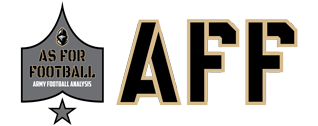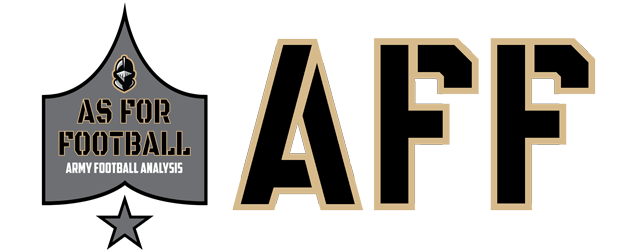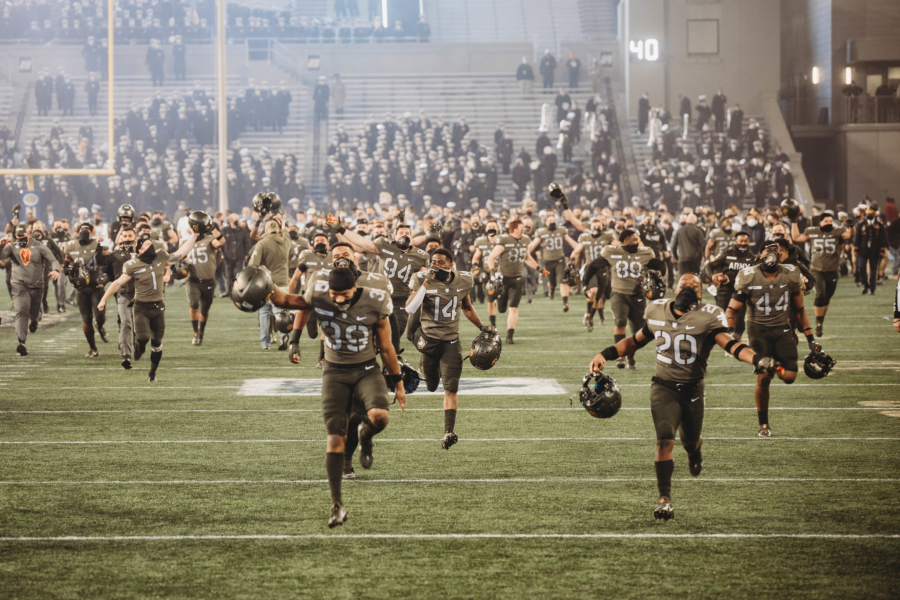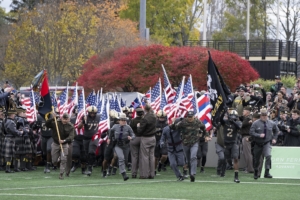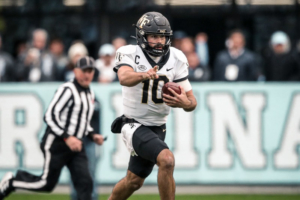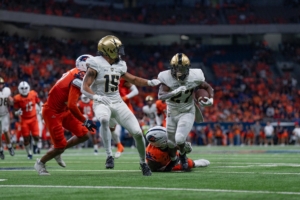Well here it is, folks. The most important game of the season is upon us. In case you need reminding, here’s what’s at stake. Army can beat Navy for the 5th time in the last 6 years, win the Commander-in-Chief’s trophy outright for the 4th time in 5 years, keep alive the possibility of a 10-win season, and win its 4th consecutive game against its sister service academies.
For Navy, a win would be perhaps the only saving grace of an otherwise disappointing season. They are a tough, dangerous team with nothing to lose and everything to gain.
East Rutherford, in the great state of New Jersey, will play host to this year’s game. The site was chosen because it is the closest suitable venue to the World Trade Center. This year marks the 20th anniversary of the September 11th attacks and MetLife Stadium sits just 8 miles from Ground Zero in Lower Manhattan.
Last year’s contest was moved to the banks of the Hudson due to Covid-19 restrictions. This year’s game will take place on the banks of the Hackensack as originally planned. That makes 2020 and ‘21 the first time the game will have been in the Greater New York City Metro Area for consecutive years since 1930 and ‘31.
Army came out victorious in both of those match-ups.
But here at As For Football, we don’t just give you a history lesson. We also preview football games. I suspect that there are a few more readers this week who don’t follow the Black Knights religiously. So the breakdown is going to look a little different. First, we’ll look at the match-up of Army’s offense and Navy’s defense. Then we’ll look at Navy’s offense and Army’s defense. We’ll finish up by looking at both special teams units and some final thoughts.
Let’s get it on!
United We Stand ??
— Army Football (@ArmyWP_Football) November 29, 2021
?https://t.co/EkKuPbML76#GoArmy pic.twitter.com/pH5h0Q8pAS
Army’s Offense vs. Navy’s Defense
Midshipmen Defense
Navy’s defense has largely become a one-man show. Linebacker Diego Fagot is by far and away the biggest playmaker on the team. He leads the defense with 85 tackles, has an interception, a forced fumble, and a sack. He is a strong run defender but is also capable in coverage.
The Midshipmen’s back seven has been plagued by injuries and other issues this season. Starting safeties Mitchell West and Kevin Brennan suffered season ending injuries against Air Force and SMU, respectively. Starting inside LB Johnny Hodges left the program due to “internal issues” and hasn’t played since the Notre Dame game. In fact, Navy’s three biggest tacklers against East Carolina were all plebes.
But Navy has some strength on their defensive front. Their top three linemen/defensive ends are J’arius Warren, Eavan Gibbons, and Taylor Robinson, who have combined for 88 tackles this year. That could easily spell trouble for Army, especially against the Fullback Dive.
Given their strength at linebacker and along the D-Line, it’s not surprising to see that Navy’s defense has been very good against the rush this year. They haven’t given up more than 160 yards on the ground since mid-October. Their secondary, however, hasn’t been as good. Only 12 teams in the FBS have given up more yards/passing attempt than Navy has.
Navy Rallies to Beat Tulsa 20-17 https://t.co/h117kIAaAr
— Navy Athletics (@NavyAthletics) October 30, 2021
Black Knight Offense
Trench Warfare
Offensive Coordinator Brent Davis has called two very different styles of games this year. We’ll call the first one “Trench Warfare.” In this style of the triple-option, you get a steady dose of the Fullback Dive and/or Midline Option with some designed Quarterback Zone Runs and an occasional Option Pitch to the outside. Very rarely do you see a pass. Trench Warfare is an offensive game plan for when you want to keep the game close, control the clock, and rely on your defense and special teams to make plays when needed.
The problem with this game plan is that you can only run it for so long. Either a team is going to make a mistake, or someone will have to take a risk. We saw this in the Army-Air Force game this year. Both teams ran “Trench Warfare” for the entire first half to no avail, and at halftime, the score sat at a whopping 0-0. Then both teams started taking some risks, and we saw a lot more scoring. Army ran this same strategy in the Wisconsin game but waited too long to start taking risks and dropped what was probably a winnable contest on the road.
If Army goes with “Trench Warfare,” expect to see FBs Jakobi Buchanan and Tyson Riley get a lot of touches. It’s unclear whether we’ll see FB Anthony Adkins after a leg injury against UMass. From a quarterback perspective, we often see Tyhier Tyler in “Trench Warfare” mode, but Christian Anderson is more than capable of running this scheme as well.
I wouldn’t be shocked to see them both in the first half. In fact, it would be kind of shocking to only see one of them.
Congrats to @ArmyWP_Football's Jakobi Buchanan, who is our Athlete of the Week, presented by @USAA.
— ArmyWestPoint Sports (@GoArmyWestPoint) December 2, 2021
The Army back had three TDs in the Black Knights' convincing win over Liberty last Saturday. #GoArmy pic.twitter.com/gEJ0hNZgBN
Shock and Awe
We’ll call the second offensive style “Shock and Awe.” With this, Army spreads it out with perimeter running plays while keeping opposing defenses honest with selective Fullback Dives. We also tend to see play-action passes and occasional Rocket Toss and/or Jet Sweep plays. We saw this in the second half against Air Force and during the first half against Liberty. This style offense requires extraordinarily detailed execution, but Army has proven themselves capable many times.
We’re more likely to see QB Christian Anderson in this package since he is the better passer. But again, it would be strange if Tyler didn’t see some snaps with this as well. Indeed, Tyler completed a long pass against Air Force that caught the Zoomies completely by surprise. In terms of impact players, expect to see SBs Tyrell Robinson and Brandon Walters with WR Isaiah Alston out wide. Robinson and Walters are the traditional pitch-men, but both have been terrific receivers out of the backfield as well.
“Shock and Awe” can be very effective when it’s executed early. It goes against tendency because we typically think of Army as a ground-and-pound rushing attack that mostly strikes between the tackles. However, Army attacked both Liberty and Wake Forest early and often, getting a big win on the road against the Flames and an (almost) season-high 56 points against the Demon Deacons’s defense.
What to Watch
Typically, in service academy rivalry games, the offenses go with “Trench Warfare” first. There are exceptions, but mostly coaches tend to play conservative and hope that their team isn’t the first to make a mistake. Both the Air Force-Navy game and the Air Force-Army game earlier this year were examples of this. Indeed, Air Force lost at Army in 2020 largely because they got too aggressive, and it backfired with a three-interception fiasco.
Despite the risk, though, Navy’s defense seems way stronger against a “Trench Warfare”-style game. Their rushing defense will cause a lot of Army punts if OC Brent Davis goes that way with it. Their depleted secondary, however, leaves them susceptible to “Shock and Awe”.
If Army can keep Navy’s secondary back on its heels, this game shouldn’t be close.
"This is a game like no other." – @CoachJeffMonken#GoArmy | #BEATnavy pic.twitter.com/005uPDfJ6R
— Army Football (@ArmyWP_Football) December 2, 2021
Navy’s Offense vs. Army’s Defense
Black Knight Defense
Army gives up just over 100 rushing yards per game, in no small part due to their defensive line. NT Nolan Cockrill and DL Kwabena Bonsu have totaled 54 tackles despite drawing frequent double-teams. Meanwhile, LBs Arik Smith and Malkelm Morrison have totaled for 105 tackles. Both guys are monster hitters versus the run.
Army has struggled at times against the pass this season, but the issue is definitely not the pass rush. OLB Andre Carter II leads the nation in sacks/game. It’s worth noting, though, that Army had 5 sacks against Liberty, and none of them were Carter’s.
The Black Knights play a bend-but-don’t break defense that blitzes frequently by leaving its secondary in man-to-man coverage down the field. This works fine against offenses that struggle to complete more than 60% of their passes, but better passing attacks with more athletic wide receivers have taken advantage of individual match-ups at times this year, to the point where Army as a whole has allowed some 220 passing yards/game.
Army attacks on defense, but they’ve had at-best mixed results when they can’t get pressure on opposing quarterbacks. We saw this most poignantly in the Wake Forest game, but both Air Force and Western Kentucky hit some deep passes down the field late in games against the Black Knights.
Proud to see this @WestPoint_USMA alum representing #AmericasTeam @ArmyWP_Football #BEATnavy! ?☠️ https://t.co/tinwfJZnmY
— Jeff Monken (@CoachJeffMonken) December 2, 2021
Midshipmen Offense
Navy’s offense has come a long way since AD Chet Gladchuck fired, rehired, and then demoted former Offensive Coordinator Ivin Jasper. Now, two of Navy’s top three rushers are fullbacks. Those players — FBs Issac Ruoss and James Harris II — are vital parts of the Navy offensive attack. If you disregard the Marshall game, which was a statistical anomaly in many ways, Navy’s fullbacks have been arguably the biggest factor in their offensive output this season. In games where the Fullback Dive averages more than 4 yards/carry, Navy scores about 11 points more than they do when the Fullbacks are even slightly less successful than that.
We expect to see QB Tai Lavatai get the start, but QB Xavier Arline has seen frequent time all season as well. Lavatai is listed at 210 pounds, and in terms of triple-option quarterbacks, he’s much more of a bruiser than he is an open-space runner. The problem is that he’s averaging just over 2 yards/carry. However, Lavatai is by far the better passer of the two. He completes about 55% of his passes but averages just under 7 yards/attempt.
On the perimeter, SBs Chance Warren and Carlinos Acie take most of the pitches. SB Mychal Cooper is the team’s leading receiver, but Warren is a legitimate target too.
Navy tends to runs shorter passing routes than Army does. This should result in a higher completion percentage for a team that doesn’t have super-accurate passers. By comparison, Army mostly uses passing to generate explosive plays. We see the difference in the following statistic — Navy has gained 20 yards/pass once in every 9 passing attempts. For Army, that statistic in 1 in 3.
Critical Match-Ups
Navy’s offense succeeds or fails on their offensive line. If the line can create enough movement for the fullbacks to gain 4 yards/play, Navy will put up at least 28 points in this game. However, if Army’s D-Line and linebackers close the gaps in the trenches, Navy is going to have to hope that QB Tai Lavatai can move the ball through the air.
If Navy can establish the Dive, they should be able to get significant yardage on the perimeter. This has long been THE fundamental principal for the triple-option offense. Thus, the key match-ups in this game exist along the line of scrimmage.
We've finally got our special unis for America's Game on Dec. 11 ???
— Army-Navy Game (@ArmyNavyGame) November 30, 2021
Who has the best threads?
Army or Navy?#ArmyNavy pic.twitter.com/x1A8F7T9Im
Special Teams
Navy has the advantage in all special teams units, except punting and kick blocking. Navy kicker Bijan Nichols has been perfect inside of 40 yards and has a long field goal of 50 this season. Army kicker Cole Talley has a long of 33.
Army and Navy have each allowed two kick return touchdowns this year. But Navy’s Marquel Haywood has also taken a kickoff to the house. On the punt return side, Army’s Tyrell Robinson can be dangerous, too, with a long of 55 yards on the year.
Army P Zach Harding gets the edge in the punting game with 15 punts dropped inside the opponents’s 20 and 10 punts of at least 50+ yards. Harding has also been very good at skying kicks; Army almost never allows significant punt return yardage in games. By comparison, Navy P Riley Riethman has a long of 65 yards but averages 3 fewer yards than Harding overall.
Final Thoughts
This game could go two different ways depending largely on Army’s offensive play calling. Army should win this game regardless of what plays in runs on offense. However, Army-Navy is always a bit of a crapshoot, and crazy things happen in football all the time.
If Army is going to win this game, they need to play their brand of football and make it work. For Navy to win, the Mids will need to dominate on defense, forcing Army mistakes, while hitting a few explosive plays on offense.
The weather for Saturday is expected to be partly cloudy with temperatures in the mid-40s to lower-50s. The game kicks at 3:00 pm ET on CBS. The primetime CBS crew of Brad Nessler and Gary Danielson will be on the call.
Strength and Honor ?? #UnitedWeStand pic.twitter.com/kfbeZnSHeu
— Army Football (@ArmyWP_Football) November 29, 2021
Go Army! Beat Navy!!!
*Cover image via USMA Flickr.
